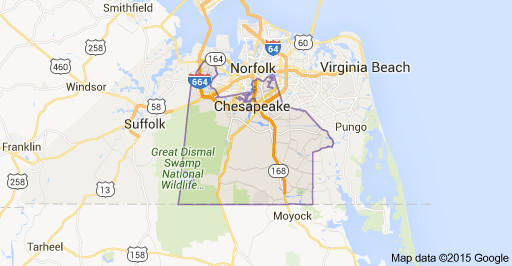
Chesapeake and Suffolk, VA – Source: http://www.google.com/search?q=map+of+chesapeake%2C+va&oq=map+of+chesapeake%2C+va&aqs=chrome..69i57j0l5.7723j0j9&sourceid=chrome&es_sm=91&ie=UTF-8
The following is a list of the largest suburbs in the USA and Canada as measured by land area (square miles). The minimum population for inclusion in the list is 10,000 residents. Three former suburbs that have become a core city were not included – Virginia Beach and Hampton, Virginia, as well as Port St. Lucie, Florida.
- Suffolk, Virginia = 429 square miles
- Buckeye, Arizona = 392 square miles
- Chesapeake, Virginia = 351 square miles
- California City, California = 204 square miles
- Levis, Quebec = 192 square miles
- Norman, Oklahoma = 189 square miles
- Texas City, Texas = 186 square miles
- Scottsdale, Arizona = 184 square miles
- Peoria, Arizona = 178 square miles
- Canyon Lake, Texas = 157 square miles
- Aurora, Colorado = 154 square miles
- Gatineau, Quebec = 147 square miles
- Caledon, Ontario = 146 square miles
- Abbotsford, British Columbia = 145 square miles
- Milton, Ontario = 142 square miles
- Mesa, Arizona = 125 square miles
- Langley, British Columbia = 122 square miles
- Surrey, British Columbia = 122 square miles
- Cape Coral, Florida = 120 square miles
- Goodyear, Arizona = 117 square miles
- Mississauga, Ontario = 113 square miles
- Henderson, Nevada = 108 square miles
- Halton Hills, Ontario = 107 square miles
- Laval, Quebec = 107 square miles
- Palmdale, California = 106 square miles
- Surprise, Arizona = 106 square miles
- Vaughn, Ontario = 106 square miles
- Brampton, Ontario = 103 square miles
- Maple Ridge, British Columbia = 103 square miles
- Chilliwack, British Columbia = 101 square miles
- North Las Vegas, Nevada = 101 square miles
- Arlington, Texas = 100 square miles
- Lehigh Acres, Florida = 96 square miles
- Palm Springs, California = 95 square miles
- Pickering, Ontario = 89 square miles
- Fremont, California = 88 square miles
- Mission, British Columbia = 87 square miles
- Markham, Ontario = 82 square miles
- Grand Prairie, Texas = 81 square miles
- Niagara Falls, Ontario = 81 square miles
- El Reno, Oklahoma = 80, square miles
- Independence, Missouri = 78 square miles
- North Charleston, South Carolina = 77 square miles
- North Port, Florida = 76 square miles
- Overland Park, Kansas = 75 square miles
SOURCE: en.wikipedia.org

How about a post on cities completely surrounded by other cities? There are tons of examples around the US.
LikeLike
Sounds like a good idea.
LikeLike
I have to call this list into question. I’m a geographer at Northwest Vista College in San Antonio, TX near #10 in the list, Canyon Lake. Canyon Lake itself (the body of water) and the area immediately surrounding it and to the north and east is mostly rural. However, the Canyon Lake Census Designated Place (CDP)(pop. of only 22,000 if we are to rely on Wikipedia) extends to what I would characterize as north San Antonio, TX…the suburban/exurban sprawl creeping out from north Bexar County (San Antonio (SA) proper is in Bexar County).
So, really what we’re looking at with #10 is the extension of San Antonio’s suburbs continuing to “super size.” And, the way this list is figured it is misleading, the Canyon Lake CDP (CL CDP) is 159 sq. miles, yet with only 22,000 people (138 people/sq. mile pop. density arithmetically). However, this population is actually concentrated along State Hwy. 281 coming out of SA and just north of the Bulverde CDP. It’s not distributed evenly across the CL CDP. I think it’s the 159 sq. mile area that gives us the impression that it’s some monstrous suburban area, but it’s not.
Which others of these are similarly misleading?
LikeLike
Your question and concern are appreciated. The purpose of the post was to identify those suburbs that occupy significant land area. A minimum population of 10,000 was utilized. Sure, there are a few sparsely populated cities in the list – Canyon Lake and California City come to mind, though they are the exception rather than the rule. It was also decided to include census designated places, as several of the large Las Vegas suburbs are not incorporated cities.
LikeLike